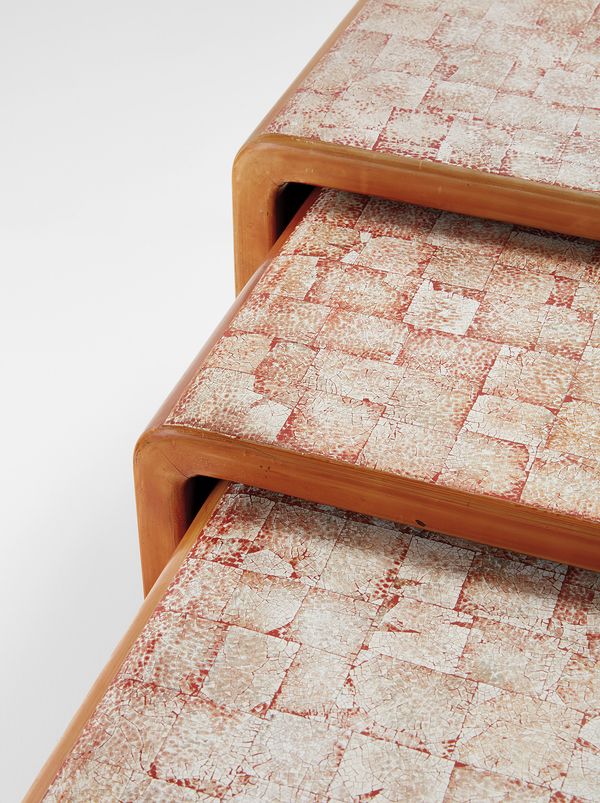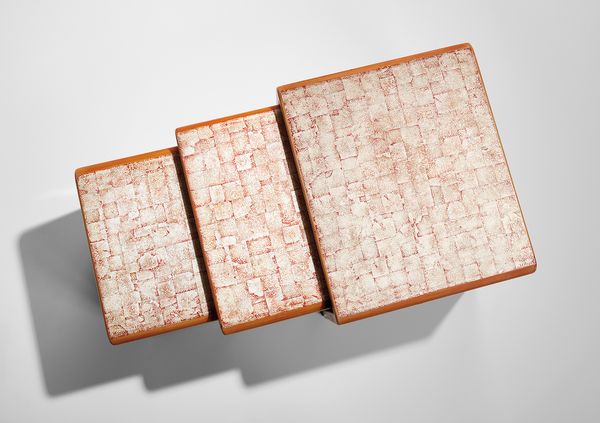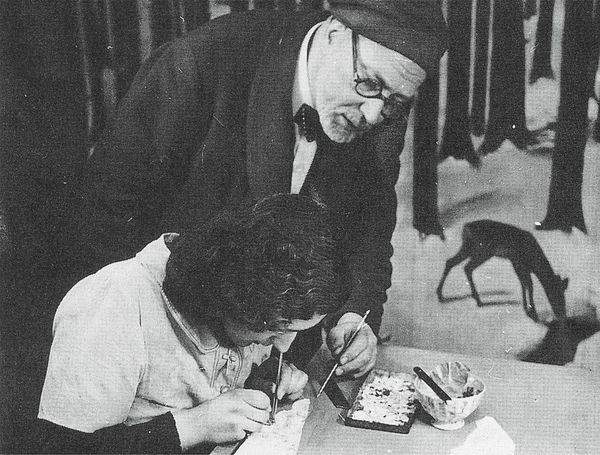Lot 54: Jean Dunand Set of three nesting tables, circa 1925.
Estimate: £120,000-150,000.
Design at Phillips London, 19 June.
Born in Switzerland, Jean Dunand studied sculpture at the École des Arts Industriels in Geneva before moving to Paris in 1897, where he apprenticed under the Art Nouveau artist Jean Dampt. Working as a sculptor until 1907, Dunand expanded his practice to include metalwork around 1903, the medium through which he first established his reputation as a preeminent artist-craftsman. Returning for periods of study to Switzerland, Dunand trained in the traditional technique of dinanderie. Working from a single sheet of metal, Dunand created elegant vessels in hammered copper, brass and bronze. Renowned for his refined finishes and surface effects, Dunand’s early metalwork retained a stylized, organic inspired decoration, which later developed into an abstract visual vocabulary, reflecting the multi-faceted style now known as Art Deco. During the 1920s, Dunand created a series of spherical vases, as illustrated by lot 53, which features a rhythmic composition of superimposed dotted shapes in gold, red and black lacquer. Exploring the relationship between form and surface, these works combine traditional artisan craftsmanship with avant-garde inspired compositions of dynamic geometric shapes in vibrant colors—demonstrative of the contending values informing the French decorative arts during this period. Often more sculptural than utilitarian in practice, Dunand’s metalwork features intricate inlays, gilding, oxidized patination and notably lacquer decoration, transforming natural materials into luxurious objects, which were readily collected by an elite Parisian clientele.
Jean Dunand Set of three nesting tables, circa 1925 (detail).
Among the few Western designers to practice the traditional art of lacquer, Dunand created original and luxurious furnishings using the rare material, demonstrating the skillful craftsmanship for which his work became renowned. Initially drawn to the use of lacquer as a technique to protect his metal surfaces, Dunand sought to master the difficult medium. Distinct from the imitation lacquer varnish prevalent in France during this period, natural lacquer is made from a resin extracted from the Rhus vernicifera—a tree indigenous to China and Japan. Once filtered using fine linen cloth to remove any impurities, the raw material is then stored in sealed bamboo baskets for several months, during which time layers of varying density form, which are then graded and priced accordingly, and adapted to different stages of use in the lengthy lacquering process. The material can be applied to different surfaces, including metal, wood, stone, leather and natural silk, the latter which Dunand also experimented with creating lacquered silk dresses and designs for couturiers including Jeanne Lanvin and Madeleine Vionnet.
Jean Dunand Set of three nesting tables, circa 1925.
In order to achieve lacquer’s highly lustrous, impermeable surface, numerous thin layers are painstakingly applied to the base surface—which in the case of wood, first must be smoothed before the grain is filled and the surface covered with a thin layer of silk or hemp using rice gum paste. The surface is then prepared by applying initial coats of lacquer mixed with sawdust from exotic woods in order to ensure the evenness of the surface. Between five to fifteen layers of clay-based lacquer are then typically added before the final stages of decorative lacquer layers are applied. Following each coat, the lacquer is slowly dried in a carefully controlled humid and dust-free environment over the course of several days. The surface is then finely sanded before the process is repeated. The Irish designer Eileen Gray had begun working with lacquer a decade earlier, initially in London and then in Paris, where she opened a workshop with the Japanese lacquer artist Seizo Sugawara. Gray’s early lacquer work demonstrated the possibilities of using the ancient craft for contemporary furnishings and in 1912 she introduced Dunand and Sugawara. Interested in the other’s respective material practices, Dunand received thirteen lessons in the demanding process of natural lacquer in exchange for introducing Sugawara to the exacting technique of dinanderie.
Jean Dunand Set of three nesting tables, circa 1925.
In its natural state lacquer dries as a rich dark brown color, whilst vegetable dyes or metal oxides can be added to the material to obtain black, different shades of brown, and vibrant orange or red. However, in order to achieve a white surface, which is not possible to create with lacquer using natural pigments, around 1925 Dunand began incorporating the technique of coquille d’œuf or eggshell lacquer in his work. The process involves delicately breaking eggshells into tiny fragments, which were organized according to size and individually inlaid on the lacquer surface to create intricate patterns. The resulting craquelure effect provides a spectacular contrast with the depth of the lustrous lacquer surface. Demonstrating his interest in surface texture and effect, Dunand explored the technique extensively in his work in lacquer. Whilst traditionally used both in Chinese and Japanese lacquerware, due to its painstaking nature, eggshell lacquer was primarily reserved for the decoration of small objects. In addition to vases, Dunand designed jewelry, trays and small boxes, as illustrated by lot 59, with delicate eggshell lacquer patterns. However, he also applied the technique on a strikingly grand scale, to create furniture, screens, and large series of wall panels.
The present set of nesting tables illustrates Dunand’s elegant eggshell lacquered furniture, which seamlessly combines simplicity of form and decoration. Descending across the three tabletops, the design features a brilliant composition integrated into the curved structure of the elegantly proportioned brown lacquer tables. The geometric pattern retains an organic quality, whilst subtly anticipating a more mechanized expression of the Art Deco style, reflected in the repetition of the set of three tables. The surface effect created by the eggshell decoration is further enhanced by the addition of red lacquer, applied over each shell and polished to the intended degree of shading. Dunand designed a multitude of eggshell lacquer compositions, experimenting with the different effects of using either the exterior or interior shell, as well as different types of eggs to achieve variations in color, heightened further by his use of shading.
Jean Dunand overseeing the application of eggshell decoration by a craftsman in his workshop, Paris, circa 1941. © Fond d'archives Félix Marcilhac, Paris.
Dunand regularly exhibited his work at the salons in Paris, notably designing a lacquer Smoking Room for the French Embassy at the landmark Exposition Internationale des Arts Décoratifs et Industriels Modernes in 1925. Throughout the 1920s and 1930s Dunand often collaborated with other designers, many of them friends including Émile-Jacques Ruhlmann, Eugène Printz and Pierre Legrain, creating refined lacquer finishes for their furniture. Dunand’s premises located at 72, rue Hallé in Paris eventually comprised a showroom, studio, and metal, lacquer and cabinetmaking workshops, where he employed a large team of highly skilled craftsmen, in addition to housing his own flock of chickens—reflecting the great success of his work in lacquer.




